Filters for rough and fine water purification: which filtration method is right for you?
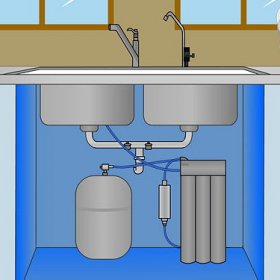
In any water entering the house autonomously from the well or centrally from the water supply, there are mechanical impurities. Untreated water can contain grains of sand, particles of scale and rust, fragments of limescale that exfoliate from the inner walls of pipes, winding elements used to seal pipe joints, and other foreign substances. Water of this quality harms not only people's health, but also household appliances, shortening its life, as well as metering devices installed by residents to save money when paying for utilities.
By installing a coarse water filter in hot or cold water supply systems, it is possible to significantly reduce the amount of abrasive particles and insoluble suspensions. Further, depending on the purpose of using each specific point of draw-off, it is recommended to install additional fine-filtering devices that can eliminate odors, organic compounds, chemical elements, compounds of heavy metals and even some microorganisms. Choose a specific filter model will help water analysiscarried out in laboratory conditions.
Content
Device and types of coarse filters
All filters that provide mechanical treatment of water have a similar device. Inside the casing along the water there is a metal mesh or other filter element (disks that cut off large fractions of sand, rust, etc.). An obligatory constructive element of such filters is a branch, in which the pollution detained by the mesh settles. If the sump is clogged, the water supply is shut off, and the outlet is cleaned and washed. The frequency of this procedure depends on the concentration of mechanical suspensions in the water. It is recommended to carry out preventive cleaning of the sump at least four times a year.
Different models of filters for mechanical water purification have a single principle of operation. However, this does not prevent them from differing from each other in a number of signs, such as: filter element, shape, method of tapping into the water supply network and the method of cleaning dirt that has settled in the sump.
Screen and cartridge filters
In the mesh strainer, a metal mesh made of stainless steel acts as a filter element. The mesh size varies between 50-400 microns. The filter is installed so that the revision cover is located below.The fixture of the filter to the piping system is carried out with the usual tools available to each plumber. When making threaded connections, ensure their absolute tightness, avoiding water leaks.
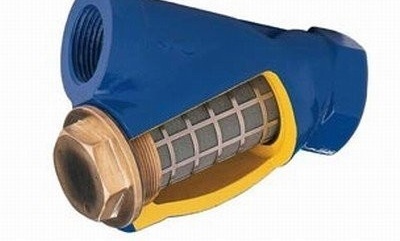
The oblique coarse strainer is equipped with a screw-in cover, which is necessary to clean the screen from dirt
Mesh filters are very popular among consumers because of their long service life, during which it is not necessary to replace the filter elements. This is their indisputable advantage that cartridge (cartridge) filters do not possess, purifying water from mechanical impurities.
Models with replaceable cartridges are attached to the wall, as their design includes a bulb of impressive size. The walls of the flask can be either transparent or not transparent. A replaceable cartridge made of polyester, twisted polypropylene yarn or pressed fiber is placed inside the flask. Cartridges have different filtering capabilities. For the implementation of rough mechanical purification of water, cartridges of 20-30 microns are selected. After clogging of the filter element, it is replaced with a new cartridge.
Important! Washing the used cartridge and its reuse in the filter is prohibited!
The installation of cartridge-type models is usually performed in tandem with mesh products, thereby providing better mechanical filtration of the water flow. In this case, the strainers are installed in front of the bulb devices. In this case, the cartridge life is extended.
Straight and oblique strainer
All types of mechanical filters have two nozzles (inlet and outlet), as well as a settling tank, in which the water flow is directly filtered. According to the location of this sump, the filter mesh is usually divided into two subspecies: oblique and straight. In the first group, the sump is at an angle with respect to the flow of water. Use oblique filters on pipes located close to the floor, as well as vertically located sections of the pipeline.
In the second group, the sump moves strictly downward, perpendicular to the flow of water. Direct filters are large, so there must be enough free space under the pipe for their installation. Due to the larger volume of the sump, vertical filters better clean water. The sump is closed using a screw plug or flange cover.
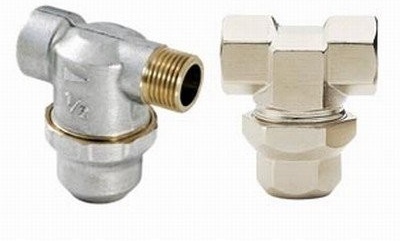
Screen filters with a vertical sump are installed on horizontally located pipes, under which there is free space for preventive maintenance
Flange and coupling strainers
According to the method of inserting a filter device into a water pipe, flange and clutch filters are distinguished. The first type of product (flange) is mounted on pipes whose diameter is two or more inches. The main water supply systems, as well as interchanges in the basements of multi-storey residential buildings, have such dimensions. Thanks to the bolt or hairpin connection of the flanges, the filter is easily removed if necessary, while the dismantling of other elements of the water supply system is not required. The installation locations of flange-type models on pipes are determined during the development of design documentation for water supply.
Important! Threaded filters are installed on pipes with a diameter of up to two inches, which are screwed onto them or connected to them with quick-release union nuts, called "American".
Sumps and strainers with flushing system
Strainers are also subdivided according to the method of purification of the sump from pollution. Non-washed products are called mud collectors. This category includes all oblique and a number of direct (vertical) strainers equipped with a removable cover.To clean the device sump from dirt, it is necessary to disassemble the device and rinse it.
Direct filters with a perpendicularly located sump equipped with a flushing system have an outlet valve. This tap allows you to drain the settled sediment into the sewage system, as well as to carry out the cleaning of the drain by direct or reverse water flow.
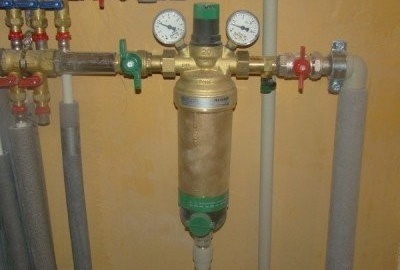
Self-washing screen filters manufactured by the German company Honeywell, a leader among companies engaged in the manufacture of this type of equipment
Fibos-type main filters with flushing system
Unlike sumps and strainers, Fibos filters fine-tune water. Their filter element is made in the form of a cylinder with a wound coil to a coil of ultra-thin microwire. The distance between adjacent turns in the winding does not exceed 1 micron. This allows you to retain not only dirt particles, but also 99% of the bacteria that form a biofilm on these particles. To prevent the Fibos filter element from becoming contaminated, the microwire is coated with a thin layer of glass insulation to prevent particles in the water from sticking to the microwire.
A microwire is a unique technology developed back in the USSR for defense and space purposes; it is the only mass production in the world.
Fibos filters are directly flushed through an outlet tap into any suitable cookware or sewer system. An additional device allows you to automate the washing process.
The performance of the Fibos filter range has wide limits. Practically without reducing the pressure in the water supply system, filters purify 5 liters of water per minute when used in the kitchen under the sink, 16 l / min when cleaning in the apartment or at the cottage, 50 l / min in the cottages, 83 l / min in the cottages, pools , up to 1000 l / min in production.
Since Fibos does fine water purification, if necessary, inexpensive cartridge filters can be installed after it to soften water, lower iron content, and remove chlorine. The life of the cartridges in this case is significantly increased.
How is fine water purification carried out?
Coarse (mechanical) filtration eliminates water from most contaminants, but it is not able to completely clear a number of chemical elements and their compounds. Therefore, manufacturers offer equipment for fine water purification, based on the use as a filter element:
- sorption materials (activated carbon or aluminosilicate);
- reverse osmosis membrane;
- ion exchange resins.
It is important to note that the working elements of these filters have to be changed. Cartridge replacement frequency is indicated by the manufacturer. This value may depend on the time of use, as well as on the volume of filtered water.
Multi-Stage Systems - Ultrafine Cleaning
In multi-stage water purification systems after mechanical filtration, the water stream is treated with ultrafine filters that are divided into several groups. More information about each of them can be found in this video:
A three-stage fine filter allows you to get good quality drinking water. The first stage is responsible for the purification of water from mechanical impurities. As a result of this stage, turbid water becomes transparent, but the cleaning process does not stop there. In the second stage, water passes through an ion-exchange cartridge, which changes its chemical composition. Petroleum products, pesticides, iron, chlorine and nitrates are removed from the water. When boiling water, which passed a two-stage purification, no scale forms on the walls and heating elements of the kettle.
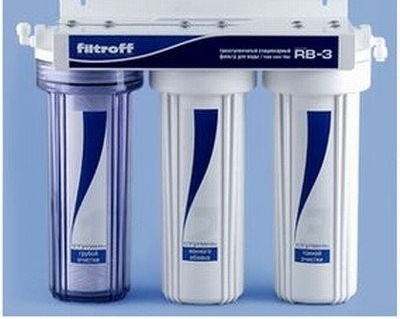
Multistage filters for ultrafine drinking water purification without pre-boiling consist of two to three flasks in which cartridges of various actions are placed
The third stage of water purification is provided by pressed activated carbon, conditioning the water flow. Water acquires a pleasant smell and taste, becomes crystal clear. Ideal for drinking. Three-bulb systems are installed in the kitchen under the sink. At the same time, the interior of the room does not suffer. To remove highly purified drinking water, an additional tap is installed at the sink.
Reverse Osmosis Filters - Molecular Purification
Reverse osmosis filters are rightly considered one of the most advanced water purification systems, since the processes proceed at the molecular level. Tap water, passing through a thin-film semipermeable membrane, the pore size of which is only 0.0001 microns, is purified from 99% of impurities. Only water molecules can leak through the pores of the membrane. Before water enters the reverse osmosis filter, it is subjected to several degrees of purification. Otherwise, reverse osmosis filters would quickly fail, clogging with large particles.
Typically, water passes through five stages of purification in such filters:
- at the first stage, a cartridge is responsible for the mechanical pretreatment of water from various impurities and suspensions (15-30 microns);
- at the second stage, activated carbon is treated with water, while gases, chlorine and organochlorine compounds are removed;
- at the third stage, fine purification of water from mechanical impurities (1-5 microns) is performed, as well as its post-treatment with compressed activated carbon;
- at the fourth stage, the reverse osmosis method works (cleaning with a thin-film membrane);
- on the fifth step is a carbon post-filter.
Reverse osmosis filters put an insurmountable barrier to such harmful substances in tap water as magnesium and mercury, strontium and arsenic, nitrates and nitrites, cyanides and asbestos, lead and fluorine, iron and chlorine, sulfates, as well as all types of bacteria and viruses. Water becomes crystal clear. Not only harmful substances are derived from it, but, unfortunately, even useful ones. Therefore, some models of reverse osmosis plants are additionally equipped with mineralizers and ionizers.
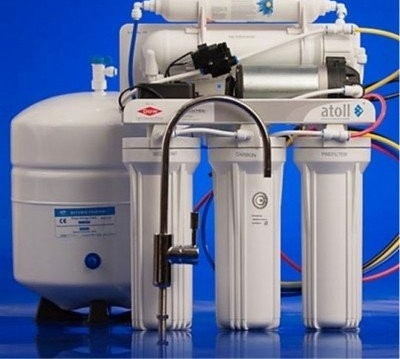
A five-stage reverse osmosis water treatment plant allows you to get the necessary supply of clean drinking water in which there are no any harmful impurities
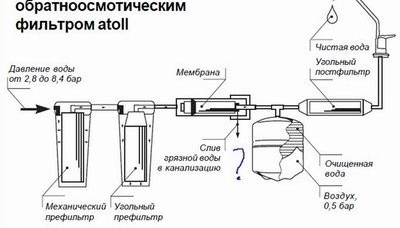
ATOLL reverse osmosis filter system installation diagram for obtaining crystal clear water to the extent necessary for family needs
It is important to say that if the water pressure in the water supply system is less than 3 atmospheres, then it is necessary to purchase a reverse osmosis filter equipped with a special pump.
Conclusions - which system do you need?
Filter selection is always made for specific purposes. To purify all the water supplied to a house or apartment to a drinking state is impractical and not economically viable. Large particles falling into tap water can be disposed of with a strainer or filter flask. They are installed on the inlet pipe of the HVS or GVS.
Need well-purified drinking water? Then put a multi-stage fine-cleaning system (with or without reverse osmosis) under the sink and put out a separate faucet for its supply. To protect plumbing and household appliances, additionally install fine filters that reduce water hardness.

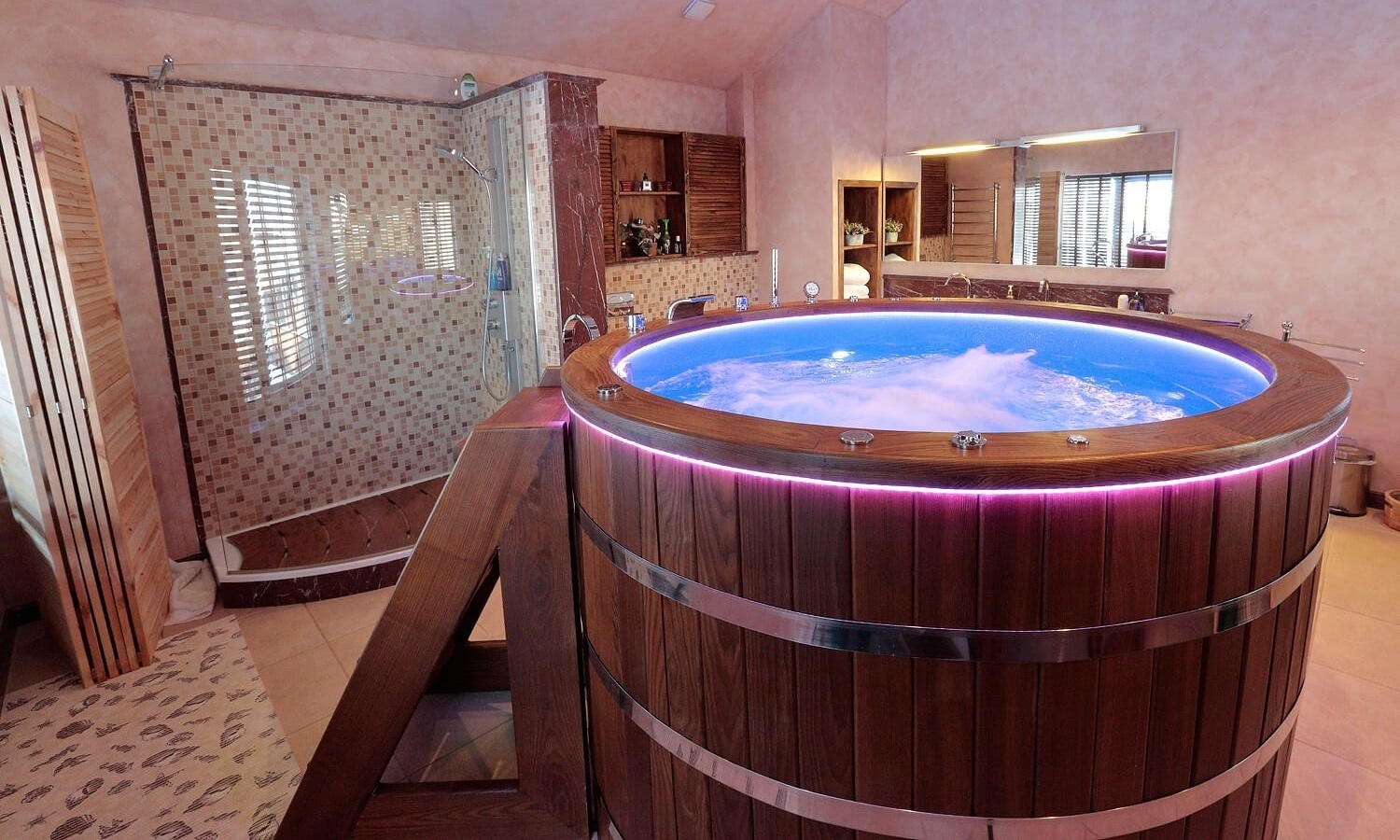
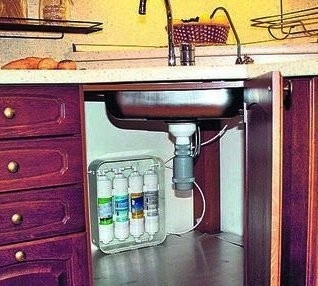
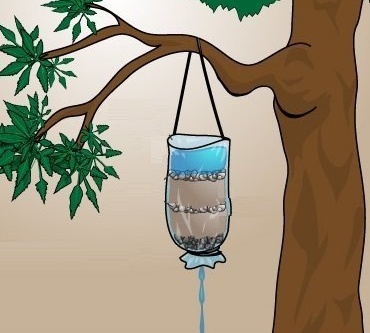
9 comments